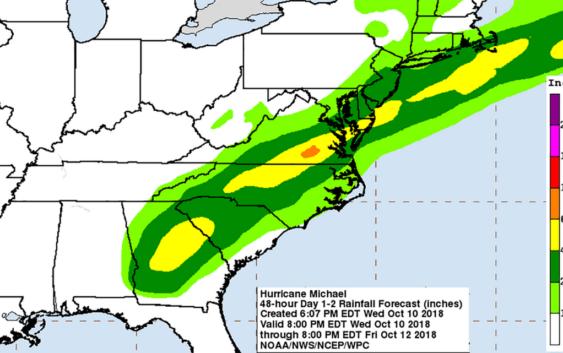- 'A little emotional': Hurricanes equipment manager got seconds in goal, memory to last a lifetime
- WMO retires three hurricane names after devastating 2024 season
- Beryl removed from future hurricane naming lists
- Hurricane names Helene, Milton and Beryl are now retired
- Hurricane Helene's name retired after deadly 2024 impact on US
Weakening Michael still a hurricane as it hits Georgia, aims at the Carolinas

This story was updated at 11 p.m. ET Wednesday.
Hurricane Michael was downgraded to a Category 1 storm on Wednesday evening, but continued to pack winds of up to 90 mph as it entered Georgia and barreled toward the Carolinas, according to the National Hurricane Center.
Michael’s maximum sustained winds were at 75 mph as of 11 p.m. Wednesday, the NHC said. A category 1 storm has winds of 74-95 mph. The storm was moving at about 20 mph to the northeast and is expected to pick up speed on Thursday and Friday.
Michael was expected to continue to weaken as it heads toward the Carolinas, dropping to a tropical storm by Thursday morning, but the storm is forecast to restrengthen as it moves off the East Coast Thursday night and Friday.
Michael moved ashore on the Florida Panhandle shortly after 1 p.m. ET as a Category 4 storm.
The storm’s eyewall hit between Panama City and Mexico Beach, Florida, bringing “life-threatening storm surge, dangerous winds and heavy rainfall,” the NHC said.
The storm’s maximum sustained winds at the time of landfall were 155 mph, according to the NHC. The storm actually intensified as it made landfall, the NHC said.
At 1 p.m., a wind gust of 119 mph was reported at Tyndall Air Force Base east of Panama City, and a gust of 116 mph was recorded at Florida State University’s Panama City campus. The storm was downgraded to a Category 3.
At 2 p.m., Michael’s eye neared Interstate 10 in the Florida Panhandle, again with potentially deadly storm surge and “catastrophic winds,” the hurricane center said in a storm update. A 102-mph wind gust was reported at Marianna Municipal Airport.
By 7 p.m., the center of the storm was moving through southwestern Georgia, according to the NHC, with wind gusts reported as high as 67 mph in Albany, Ga.
At 11 p.m., the NHC reported the center of the weakening hurricane was about 45 mile south of Macon, as it continued across southwestern and central Georgia overnight. Hurricane-force winds extended outward up to 30 miles from the center and tropical-storm-force winds extended outward up to 160 miles.
Michael’s impact will be felt through the Carolinas into Virginia, including predictions of 3 to 8 inches of rain, according to the NHC, which could lead to “life-threatening flash floods” and possible tornadoes in South Carolina on Thursday morning.
NC Gov. Roy Cooper declared a state of emergency across North Carolina Wednesday morning, referring to Hurricane Michael as “a dreadful storm” in a press release. Cooper also activated the National Guard, and as of Wednesday evening, 150 troops had reported for duty.
Duke Energy announced Wednesday evening that Michael could cause as many as half a million power outages in the Carolinas.
A Tropical Storm Warning was issued for much of central and eastern North Carolina and most of South Carolina as of Wednesday evening, many of the same areas hit last month by Hurricane Florence.
But South Carolina Gov. Henry McMaster is not predicting the same punch that Florence delivered.
“This will not be, as far as we can tell, a repeat of what we saw in Florence,” McMaster said, according to The State. “It will not be like Hugo. It will be high winds and a good bit of water.”
But prior to that, McMaster issued an order keeping South Carolina in a state of emergency and allowing resources deployed during Hurricane Florence to stay in play.
Dare County warned residents and visitors to prepare for “tropical storm force winds, heavy rain, and possibly 2-4 feet of above ground soundside flooding.”
“The overly saturated ground and weakened trees will still allow for an elevated wind risk and some power outages will occur. Flash flooding will also be possible though the storm’s rapid motion should limit rainfall amounts,” the National Weather Service said in a hurricane update.
The effects of Hurricane Michael will reach the Columbia area around 4 a.m. Thursday, according to National Weather Service meteorologist Frank Alsheimer. That will include heavy rain and tropical storm-force winds until noon time.